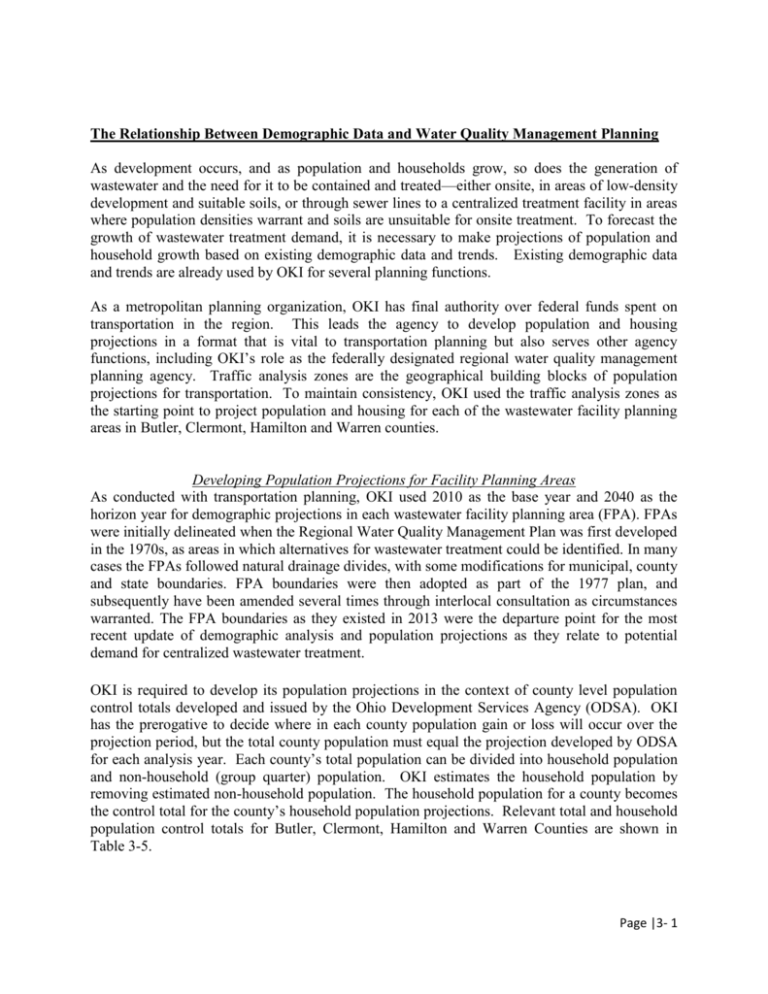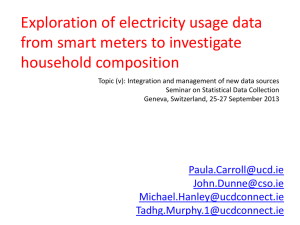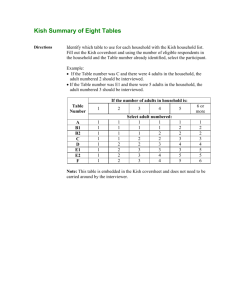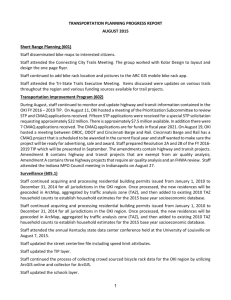Click here for updated text describing the methodology used in
advertisement

The Relationship Between Demographic Data and Water Quality Management Planning As development occurs, and as population and households grow, so does the generation of wastewater and the need for it to be contained and treated—either onsite, in areas of low-density development and suitable soils, or through sewer lines to a centralized treatment facility in areas where population densities warrant and soils are unsuitable for onsite treatment. To forecast the growth of wastewater treatment demand, it is necessary to make projections of population and household growth based on existing demographic data and trends. Existing demographic data and trends are already used by OKI for several planning functions. As a metropolitan planning organization, OKI has final authority over federal funds spent on transportation in the region. This leads the agency to develop population and housing projections in a format that is vital to transportation planning but also serves other agency functions, including OKI’s role as the federally designated regional water quality management planning agency. Traffic analysis zones are the geographical building blocks of population projections for transportation. To maintain consistency, OKI used the traffic analysis zones as the starting point to project population and housing for each of the wastewater facility planning areas in Butler, Clermont, Hamilton and Warren counties. Developing Population Projections for Facility Planning Areas As conducted with transportation planning, OKI used 2010 as the base year and 2040 as the horizon year for demographic projections in each wastewater facility planning area (FPA). FPAs were initially delineated when the Regional Water Quality Management Plan was first developed in the 1970s, as areas in which alternatives for wastewater treatment could be identified. In many cases the FPAs followed natural drainage divides, with some modifications for municipal, county and state boundaries. FPA boundaries were then adopted as part of the 1977 plan, and subsequently have been amended several times through interlocal consultation as circumstances warranted. The FPA boundaries as they existed in 2013 were the departure point for the most recent update of demographic analysis and population projections as they relate to potential demand for centralized wastewater treatment. OKI is required to develop its population projections in the context of county level population control totals developed and issued by the Ohio Development Services Agency (ODSA). OKI has the prerogative to decide where in each county population gain or loss will occur over the projection period, but the total county population must equal the projection developed by ODSA for each analysis year. Each county’s total population can be divided into household population and non-household (group quarter) population. OKI estimates the household population by removing estimated non-household population. The household population for a county becomes the control total for the county’s household population projections. Relevant total and household population control totals for Butler, Clermont, Hamilton and Warren Counties are shown in Table 3-5. Page |3- 1 Table 3-5: County Populations for 2010 and 2040 2010 Total 2040 Total Population Population Control Total Control Total Butler 368,130 430,360 Clermont 197,363 216,190 Hamilton 802,374 786,090 Warren 212,693 239,060 *U.S. Census, 2010, Summary File 1, DP-1 County 2010 Household Population Control Total* 357,177 195,646 782,863 206,708 2040 Household Population Control Total 419,407 214,470 766,309 233,025 The 2010 Census served as the statistical foundation of household and population data in base year 2010. OKI used census blocks, which are the smallest geographical units for a federal census, to allocate figures on the 2010 Census households, household population and group quarter population to the previously mentioned traffic analysis zones. This was done in proportion to land areas through use of ArcMap, a geographic information system software. Household size for each traffic analysis zone was calculated by dividing the zone’s population by its number of households. Year 2010 household population for each traffic analysis zone was estimated by first multiplying the 2010 number of households by the 2010 Census household size. The household size was then factored so that the sum of household population across all TAZs in a county equaled the 2010 county household population control total. The total population in each TAZ was calculated by adding the non-household (group quarter) population to the household population. Once the number of households and total population were established for base year 2010 for each TAZ, the data was aggregated to the facility planning areas on an area proportion basis through use of ArcMap. The year 2040 is the horizon year (i.e., future year) for OKI’s planning work. The horizon year population and households for each traffic analysis zone were developed based on multiple factors. Staff consulted all available comprehensive plans and related studies for jurisdictions within the study area for population projections and anticipated development trends, as well as current and future land use maps. Build-out housing unit estimates within each TAZ were calculated by measuring the acres of developable vacant land assigned to residential use in the future and multiplying that number by the future residential land use’s associated density. These build-out calculations provided a ceiling for the allocation of future households. Based on these considerations, a portion of the county's household change was allocated to the TAZ. Review also resulted in removing some of the existing households in areas of population decline, deteriorating housing, or clearance. Once the determination of households for 2040 for TAZs was made, the year 2010 household size was multiplied by the household total in each TAZ to determine the population associated with the 2040 households. Adjustments were made to the household size so that the sum of household population across all TAZs in a county equaled the county household control total, as shown by Table 3-5. The TAZ household population was combined with the non-household (group quarter) population and then aggregated to the facility planning areas (FPAs) using area proportion in ArcMap. These preliminary FPA projections were then subjected to the scrutiny of expert review. Page |3- 2 OKI began review of the preliminary 2040 facility planning area projections by meeting with local planners, engineers, wastewater personnel, and other individuals knowledgeable about residential development trends in each county in the study area. These individuals helped OKI staff by: 1. identifying areas of anticipated growth on maps (see Figure 3-7) 2. reacting to preliminary 2040 population projections for each facility planning area 3. identifying areas targeted for new water service, sewer service or both 4. indicating where substantive transportation improvements were under way or planned 5. providing electronic or hard copy itemization of approved subdivisions, which identified the subdivision locations and numbers of lots (built and unbuilt) After the meetings with local planners, engineers, and wastewater personnel, OKI staff revisited the preliminary population projections for each facility planning area to ensure that they conformed to anticipated land uses and densities and reflected guidance provided by the local planning authorities. Facility Planning Area (FPA) Boundary Updates As a result of interlocal consultations with neighboring wastewater management agencies in Butler, Clermont, Hamilton and Warren counties during the plan update process, OKI has updated wastewater FPA boundaries both to reflect evolving conditions and the availability of electronic mapping capabilities which did not exist when the original plan was prepared. The methodology previously described was then applied to the updated FPA boundaries as reflected in Figure 3-8, which shows base year and horizon year populations for each facility planning area for ease of reference. Overlay Facility Planning Areas A slightly different approach was used to develop population projections for the overlay facility planning areas, which include Batavia, Moscow and New Richmond Village in Clermont County, Whitewater Township in Hamilton County and Lebanon/South Lebanon, Mason and Waynesville in Warren County. These overlay facility planning areas reflect their designation for providing wastewater service within their jurisdictional boundaries in the original plan, in plan amendments or, in the case of the Whitewater Township Regional Sewer District, co-designation with the Metropolitan Sewer District of Greater Cincinnati for the area within Whitewater Township boundaries pursuant to their interlocal agreement. Population data from the 2010 Census was available specifically for these jurisdictions. For 2040, the area proportion technique used for apportioning traffic analysis zone data to facility planning areas was inappropriate for the smaller jurisdictions comprising several of the overlay facility planning areas. Instead, 2040 population projections for the overlay facility planning areas were developed based on several factors, including the number of household units already approved for development by local planning authorities, local comprehensive plans, residential sewer connections projected by local providers for 2040, and 2010 census household size. The base year and horizon year populations for each facility planning area (FPA) were mapped for easy reference and comparison. Figure 3-8 shows these FPA populations, which are to be considered as OKI final projections for 2040. Page |3- 3 Figure 3-7: Anticipated Growth Areas and Recommended Facility Planning Areas in Butler, Clermont, Hamilton and Warren Counties Page |3- 4 Figure 3-8: 2010 Population and 2040 Population Projections for Facility Planning Areas in Butler, Clermont, Hamilton and Warren Counties Page |3- 5 In considering development trends, population projections and associated potential needs for centralized wastewater treatment, OKI continues to be mindful of the relationship between the timing and location of infrastructure improvements and the timing and location of development. The Strategic Regional Policy Plan adopted by OKI in 2005 stresses “the need to time and locate (wastewater) infrastructure improvements concurrently with development. . . . The haphazard provision of public facilities is almost always more costly to taxpayers than if a planned capital improvements schedule were employed.” When centralized sewage service lags behind development, inefficiencies arise. In their 2001 report titled Cincinnati Metropatterns: A Regional Agenda for Community Stability, Myron Orefield and Thomas Luce state: “It costs more to retrofit or expand infrastructure such as sewers and roads to low density, sprawling communities after the houses are built than it does to provide such infrastructure to well planned neighborhoods as they develop. ” OKI’s Strategic Regional Policy Plan names centralized sewage service as one of the key factors for guiding development. It states: “The placement of public facilities, specifically water, sewers, and roads and their capacities affects the location and intensity of new development. Publicly funded capital improvements can be used as inducements for new development; they can direct and manage land development and redevelopment. Public facilities can draw development to various specific locations. The provision of public facilities and services without proper planning and analyses may mean communities trend towards scattered, untimely, poorly planned development in urban fringe and rural areas. These patterns are typically manifested in one or more of the following ways: leapfrog development; ribbon or strip development; and large expanses of low-density, single-dimensional development.” Further, the plan notes that a continuation of such patterns “will result in costly long-term impacts, including scattered, untimely, poorly planned extension of water, sewer, and road facilities and services.” The Strategic Regional Policy Plan also favors a watershed protection approach, saying it “has the potential to refocus existing water pollution control programs on more comprehensive goals, while bringing more players into the picture.” At the same time, the Strategic Regional Policy Plan acknowledges: “Protection and sustainability of water resources are most effectively addressed on a watershed basis, while local governments make planning and budgeting decision on a jurisdictional basis.” The Strategic Regional Policy Plan directs OKI to share information about watersheds while assisting local governments and watershed groups in watershed management efforts. Page |3- 6






